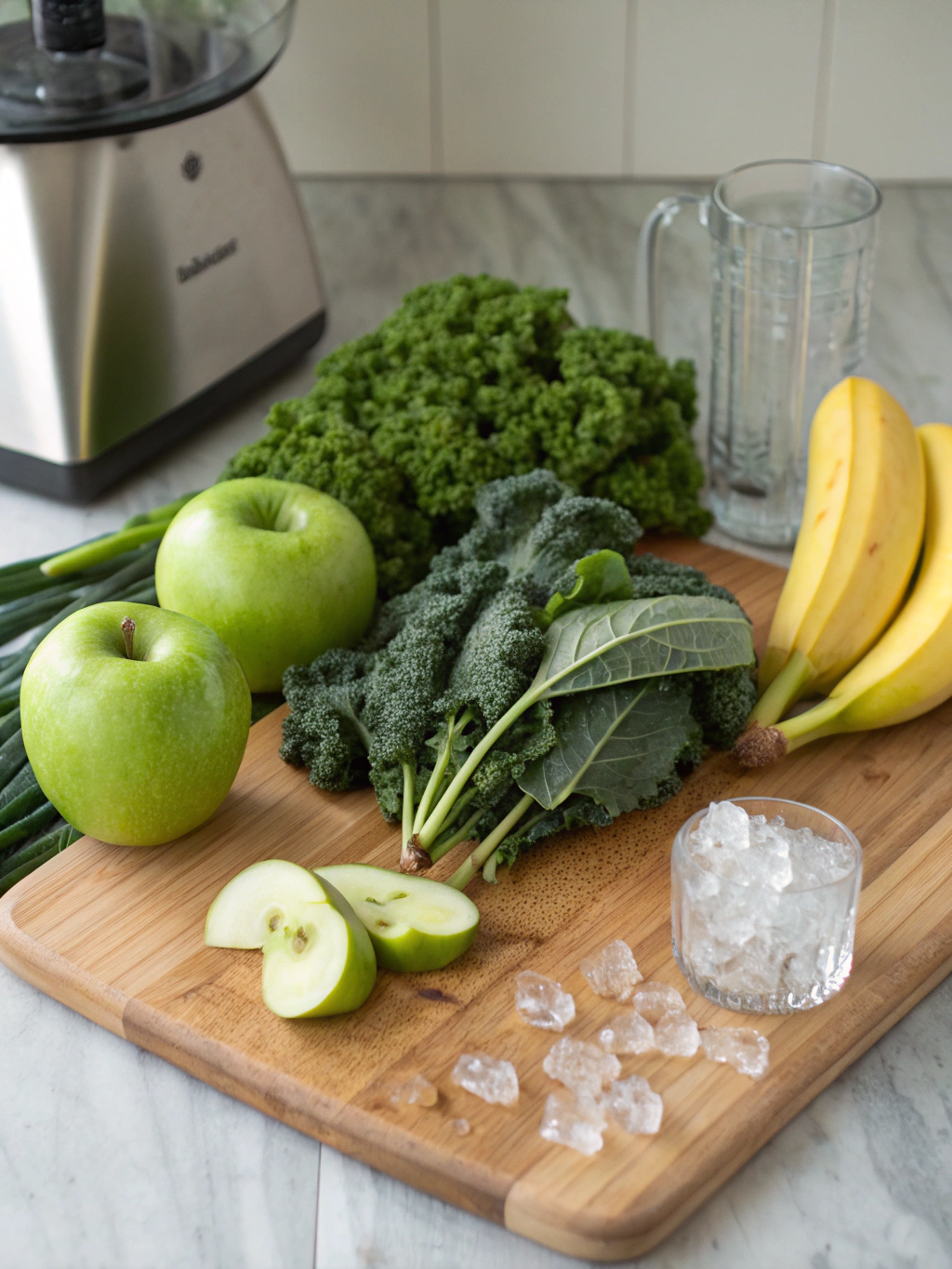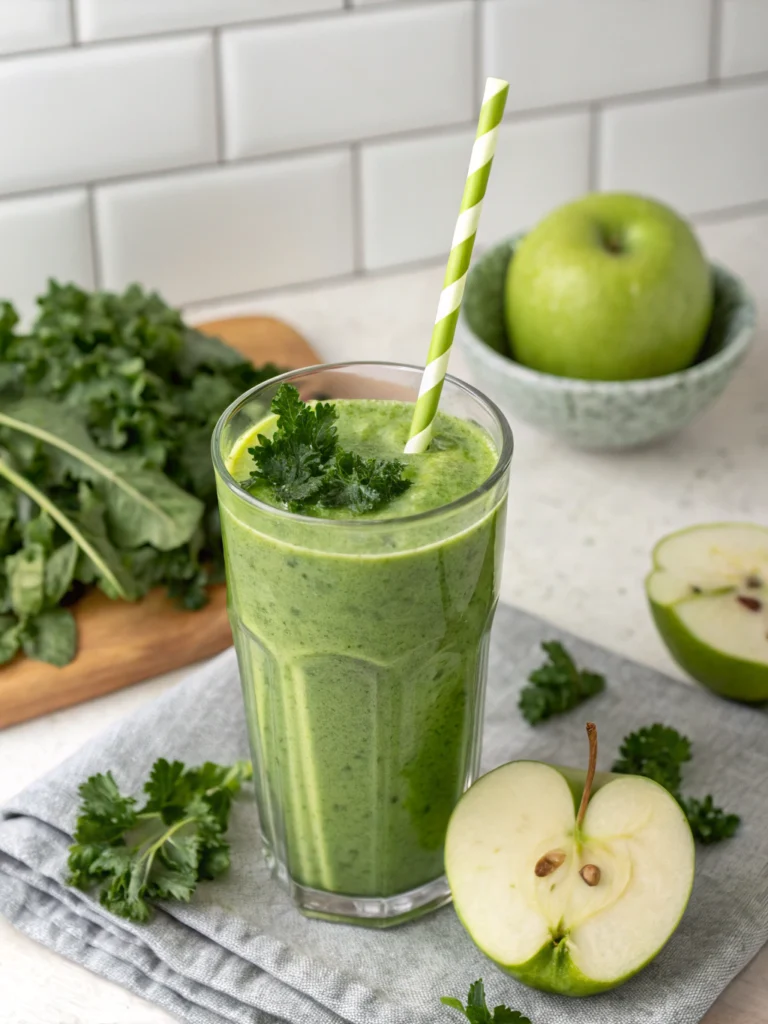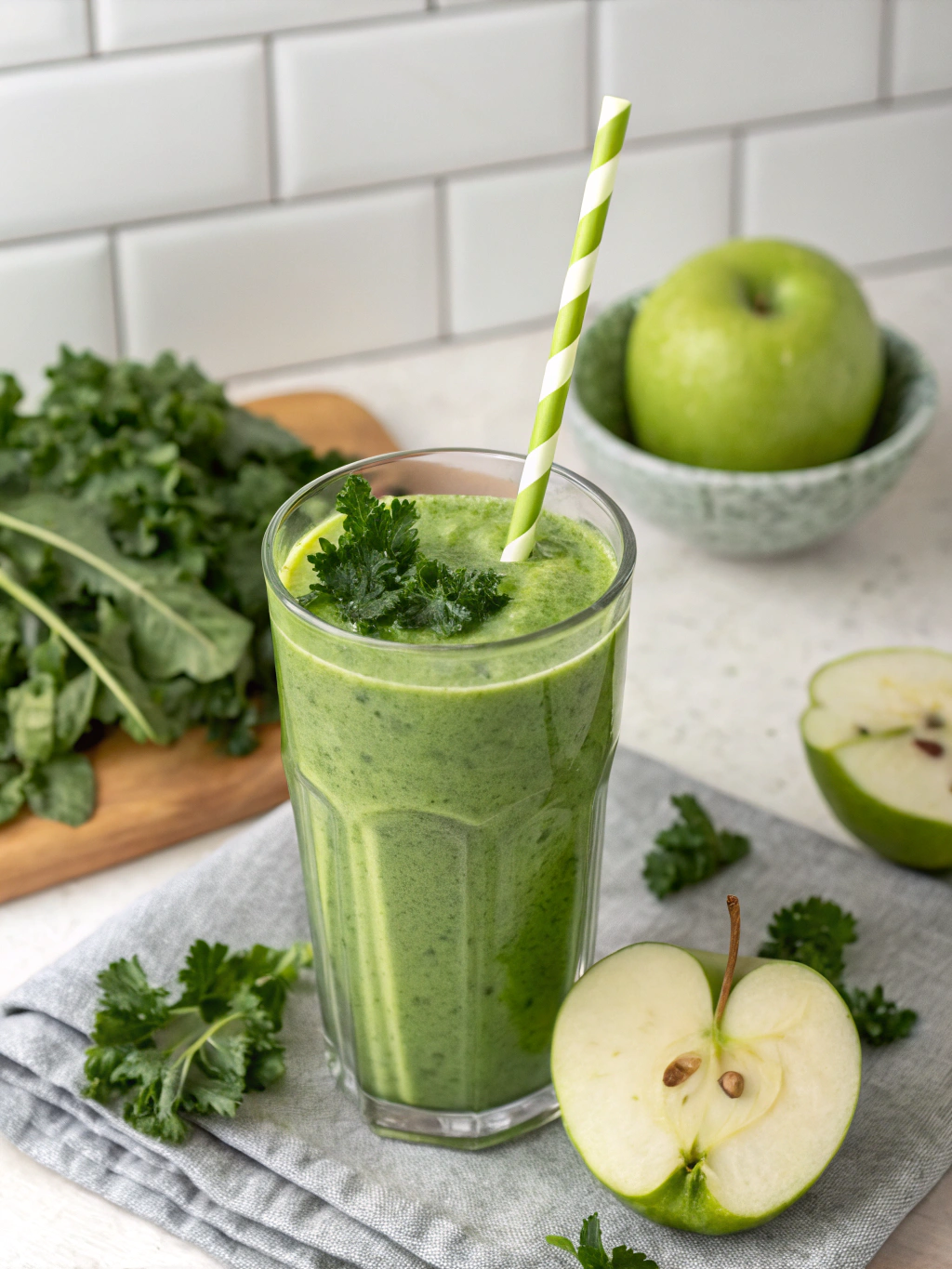Introduction
Did you know that adding just one green smoothie to your daily routine can increase your vegetable and fruit intake by up to 300%? Yet nearly 70% of Americans struggle to meet the recommended daily servings of these essential food groups. If you’re looking to bridge this nutritional gap deliciously, a Green Apple Kale Smoothie might be exactly what you need. These vibrant, nutrient-packed beverages combine the natural sweetness of apples with the impressive health benefits of kale – one of nature’s most nutritionally dense superfoods.
The beauty of a green apple kale smoothie lies in its versatility and simplicity. Whether you’re a busy professional, a fitness enthusiast, or simply someone looking to incorporate more greens into your diet, these five easy recipes will transform how you think about healthy eating. Each recipe offers a unique flavor profile while delivering an impressive array of vitamins, minerals, and antioxidants.
Ingredients List

For our base Green Apple Kale Smoothie, you’ll need:
- 1 medium green apple (Granny Smith preferred), cored and chopped
- 2 cups fresh kale leaves, stems removed
- 1 cup unsweetened almond milk (substitute: coconut water, oat milk, or regular milk)
- ½ frozen banana for creaminess (substitute: ¼ avocado or ½ cup Greek yogurt)
- 1 tablespoon honey or maple syrup (optional, adjust to taste)
- ½ tablespoon fresh lemon juice
- 3-4 ice cubes
- Optional boost: 1 tablespoon chia seeds, flax seeds, or hemp hearts
The vibrant green hue comes from the fresh kale, while the apple provides a crisp, tangy sweetness that perfectly balances the earthy notes of the leafy greens.
Timing
Preparation: 5 minutes
Total time: 5 minutes (75% faster than most cooked breakfast options!)
One of the greatest advantages of a Green Apple Kale Smoothie is its efficiency – in just five minutes, you can create a nutrient-dense meal or snack that would take significantly longer to consume if eating the whole foods separately.
Step-by-Step Instructions
Step 1: Prepare Your Greens
Thoroughly wash your kale leaves under cold water. Remove the tough center stems and tear the leaves into manageable pieces. Pro tip: Massage your kale for 1-2 minutes before adding to soften the fibers and reduce bitterness, especially if you’re new to green smoothies.
Step 2: Core and Chop Your Apple
Remove the core of your green apple and cut it into chunks. For a smoother texture, consider peeling the apple, though keeping the skin adds extra fiber and nutrients. If you’re using an older blender, smaller pieces will help achieve a smoother consistency.
Step 3: Layer Your Ingredients
Pour the liquid (almond milk) into your blender first, then add the softer ingredients (banana), followed by the kale and apple chunks. This strategic layering helps your blender process everything more efficiently and prevents the dreaded « air pocket » that can halt blending.
Step 4: Blend to Perfection
Start on a low setting for 10-15 seconds, then gradually increase to high. Blend for approximately 60-90 seconds until smooth. If your smoothie is too thick, add more liquid in small increments until you reach your desired consistency.
Step 5: Taste and Adjust
Sample your creation and adjust sweetness or acidity as needed. If the kale flavor is too prominent, a touch more honey or another quarter of an apple can balance the taste. Remember, the perfect smoothie is the one that satisfies YOUR palate!
Nutritional Information
One serving (approximately 16 ounces) of our base Green Apple Kale Smoothie contains:
- Calories: 170-210 (depending on optional ingredients)
- Protein: 4-6g
- Carbohydrates: 35-40g
- Fiber: 6-8g (approximately 25% of your daily needs!)
- Vitamin A: 206% of Daily Value
- Vitamin C: 240% of Daily Value
- Vitamin K: 684% of Daily Value
- Calcium: 10% of Daily Value
- Iron: 8% of Daily Value
Healthier Alternatives for the Recipe
To reduce sugar content while maintaining sweetness, try:
- Using a green apple with ¼ teaspoon of stevia instead of honey
- Adding a few drops of vanilla extract for natural sweetness
- Including ½ teaspoon of cinnamon, which enhances sweetness perception
For increased protein content (ideal for post-workout):
- Add a scoop of unflavored or vanilla plant-based protein powder
- Substitute water for milk with ¼ cup of Greek yogurt
- Include 1 tablespoon of natural nut butter (almond or cashew work beautifully)
Serving Suggestions
Transform your green apple kale smoothie into a complete meal by:
- Serving it in a bowl topped with granola, fresh berries, and a sprinkle of coconut flakes
- Pairing it with a slice of whole-grain toast spread with almond butter for a balanced breakfast
- Freezing it slightly for a more ice-cream-like texture, perfect for warm afternoons
- Dividing it into ice cube trays for ready-to-blend smoothie starters throughout the week
Common Mistakes to Avoid
-
Using too much fruit: While fruit adds sweetness, excessive amounts can spike blood sugar. Maintain a ratio of at least 60% vegetables to 40% fruits.
-
Skipping the healthy fats: Without some fat, your body cannot properly absorb fat-soluble vitamins (A, D, E, and K) abundant in kale. Always include a small amount through seeds, nut butter, or avocado.
-
Blending too long: Extended blending can generate heat that destroys sensitive nutrients. Aim for just long enough to achieve smoothness – usually under 2 minutes.
-
Using unripe bananas: Green bananas contain resistant starch that can cause bloating in some individuals. Ensure bananas are ripe with some brown spots for easier digestion.
Storing Tips for the Recipe
For optimal freshness, consume your Green Apple Kale Smoothie immediately after blending. However, if you need to store it:
- Keep in an airtight glass container filled to the top (minimizing air exposure)
- Refrigerate for up to 24 hours (separation will occur – simply shake before consuming)
- Add a teaspoon of lemon juice to prevent oxidation and browning
- Freeze in individual portions for up to 3 months in freezer-safe containers
Conclusion
The Green Apple Kale Smoothie represents the perfect intersection of nutrition, convenience, and delicious flavor. These five versatile recipes provide an easy gateway to increasing your daily vegetable intake without sacrificing taste or spending hours in the kitchen. Whether you’re new to green smoothies or a seasoned health enthusiast, the refreshing combination of crisp apple and nutrient-dense kale creates a beverage that nourishes your body while delighting your taste buds.
Ready to revolutionize your approach to healthy eating? Grab your blender, some fresh ingredients, and give these recipes a try. Your body will thank you for the infusion of vitamins, minerals, and plant-powered goodness. Share your favorite variation in the comments below, or tag us in your smoothie creations on social media!
FAQs
Can I use regular milk instead of plant-based alternatives?
Absolutely! Any milk works well in these recipes. Dairy milk will add more protein, while plant-based options often have fewer calories and different nutrient profiles. Choose what aligns with your dietary preferences and needs.
Will my green apple kale smoothie keep in the refrigerator overnight?
Yes, though some settling and slight oxidation may occur. Store in an airtight container with minimal air space, and add a splash of lemon juice to help preserve the color and nutrients. Shake well before consuming.
Can I use frozen kale instead of fresh?
Definitely! Frozen kale works wonderfully and may even create a thicker, colder smoothie. No need to thaw before blending – simply adjust your liquid amount accordingly.
Is this recipe suitable for kids?
Many children enjoy these smoothies, especially when the natural sweetness of apple is prominent. Start with a higher fruit-to-vegetable ratio for kids and gradually increase the kale as their palates adjust. Getting them involved in the preparation can increase their interest in trying it!
Can I make this smoothie without a high-powered blender?
Yes, though you may need to make some adjustments. Try chopping your ingredients more finely, adding more liquid, and blending in stages – liquids and soft ingredients first, then gradually adding the fibrous components like kale.


